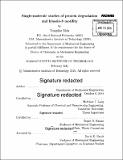| dc.contributor.advisor | Matthew J. Lang. | en_US |
| dc.contributor.author | Shin, Yongdae | en_US |
| dc.contributor.other | Massachusetts Institute of Technology. Department of Mechanical Engineering. | en_US |
| dc.date.accessioned | 2015-07-17T19:52:35Z | |
| dc.date.available | 2015-07-17T19:52:35Z | |
| dc.date.copyright | 2015 | en_US |
| dc.date.issued | 2015 | en_US |
| dc.identifier.uri | http://hdl.handle.net/1721.1/97843 | |
| dc.description | Thesis: Ph. D., Massachusetts Institute of Technology, Department of Mechanical Engineering, 2015. | en_US |
| dc.description | Cataloged from PDF version of thesis. | en_US |
| dc.description | Includes bibliographical references (pages 97-106). | en_US |
| dc.description.abstract | Molecular machines drive living organisms out of equilibrium and perform critical functions in almost every aspect of cellular processes. They are mechanical enzymes transducing free energy stored in chemical forms to generate motions and forces useful in cell. How these tiny machines operate in the presence of thermal agitation has been studied for a few model systems but still largely elusive. Especially, mechanisms of how molecular machines that were evolved from common ancestors diversified their machine actions to fit specific cellular requirements need to be answered. This thesis explores mechanisms of molecular machines in an effort to reveal roles of thermal fluctuations on machine functions, using two biological systems: ClpXP proteases and kinesin-8 Kif18B. As members of bigger protein families, these two fascinating nanomachines perform important cellular tasks in protein quality control and spindle formation, respectively. AAA+ ClpX unfoldases use energy from ATP binding and hydrolysis to drive mechanical unfolding and translocation of target proteins to associated peptidase ClpP. Previous ensemble biochemical and structural studies uncovered many aspects of degradation activity of ClpXP but the mechanistic understanding of ClpXP function is currently still lacking. We employed single-molecule biophysical techniques including optical trapping and single-molecule fluorescence to directly monitor unfolding and translocation activity of single ClpX hexamer as well as conformational dynamics of single subunit of ClpX. Statistical kinetic analyses on unfolding and translocation uncovered that unfolding kinetics were dominated by futile ATP hydrolysis and translocation steps contained more than one rate-limiting process for each physical stepping. Single-molecule fluorescence resonance energy transfer (sm- FRET) assay revealed dynamic switching of ClpX subunit conformations between multiple states. In the absence of nucleotide, ClpX explored available conformational spaces thermally in an erratic manner. Nucleotide binding to ClpX hexamer leads to ring contraction as well as defined hexameric conformation arrangements. Conformational transitions were not directly coupled to ATP hydrolysis, suggesting an important role of thermal fluctuation in ClpX machine function. The Kinesin-8s are plus-end directed motors that negatively regulate microtubule length. The canonical members of this kinesin sub-family showed ultra-processivity which enables Kinesin-8s to enrich preferentially at the plus-ends of microtubules to alter microtubule dynamics. Kif18B is an understudied human Kinesin-8 that also limits MT growth during mitosis. Using single-molecule assays, we found that Kif18B was only modestly processive, and that the motor switched frequently between plusend directed and diffusive modes of motility. Measurements with truncated motors showed diffusion was promoted by a second MT-binding site located in the Kifl8B tail. Our model accounting for motility switching is consistent with autoinhibition mechanism of Kinesin-1, implying that kinesins may share common regulatory mechanisms to drive varying functional consequences. | en_US |
| dc.description.statementofresponsibility | by Yongdae Shin. | en_US |
| dc.format.extent | 106 pages | en_US |
| dc.language.iso | eng | en_US |
| dc.publisher | Massachusetts Institute of Technology | en_US |
| dc.rights | M.I.T. theses are protected by copyright. They may be viewed from this source for any purpose, but reproduction or distribution in any format is prohibited without written permission. See provided URL for inquiries about permission. | en_US |
| dc.rights.uri | http://dspace.mit.edu/handle/1721.1/7582 | en_US |
| dc.subject | Mechanical Engineering. | en_US |
| dc.title | Single-molecule studies of protein degradation and kinesin-8 motility | en_US |
| dc.type | Thesis | en_US |
| dc.description.degree | Ph. D. | en_US |
| dc.contributor.department | Massachusetts Institute of Technology. Department of Mechanical Engineering | |
| dc.identifier.oclc | 913421560 | en_US |
